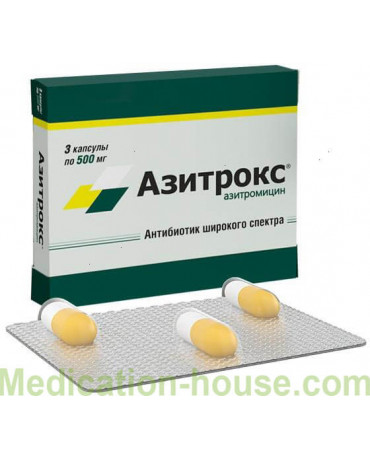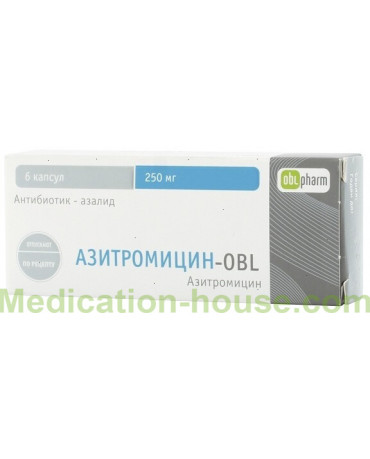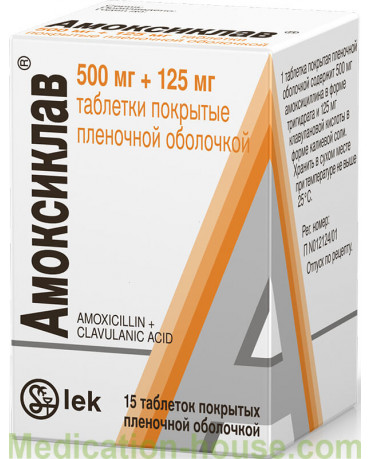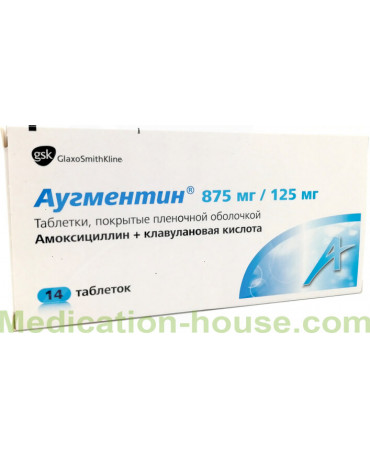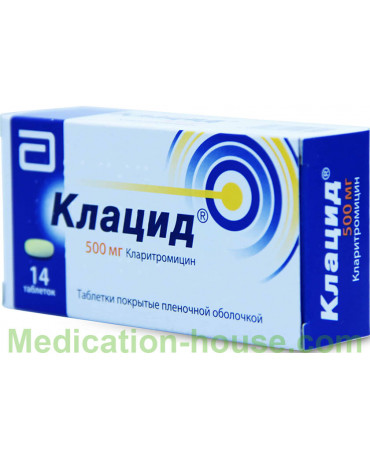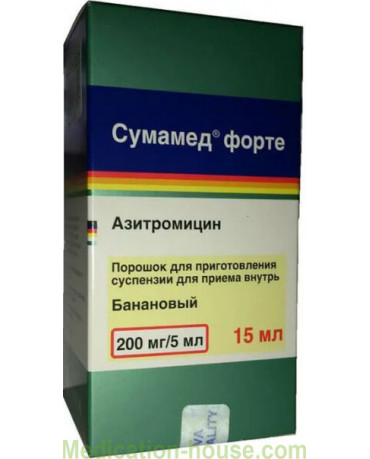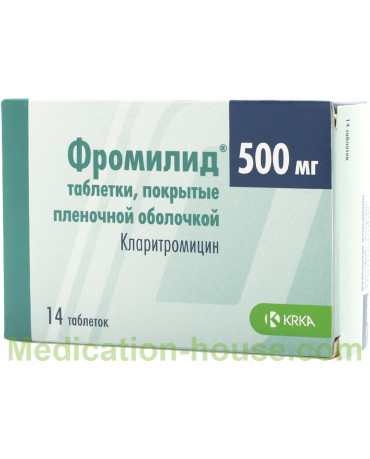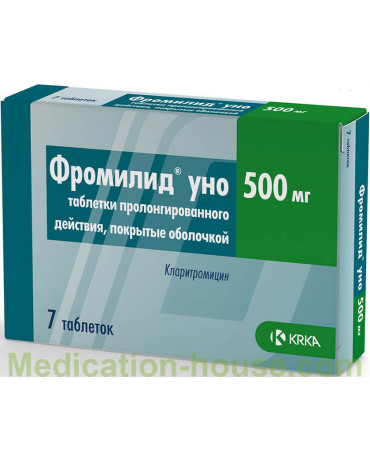Sumamed capsules instruction
You can buy Sumamed capsules here
Composition
active ingredient: azithromycin;
1 capsule contains azithromycin 250 mg as a dihydrate;
excipients: microcrystalline cellulose, sodium lauryl sulfate, magnesium stearate, gelatin, titanium dioxide (E 171), indigo (E 132), sulfur dioxide (E 220).
Dosage Form
Capsules.
Main physical and chemical properties: hard gelatin capsules No. 1, with an opaque blue body and an opaque blue lid; capsule contents: crystalline powder from white to yellowish or lump of crystalline powder, from white to yellowish.
Pharmacological group
Antibacterial agents for systemic use. Macrolides, linkosamides and streptogramins. Azithromycin. ATX code J01F A10.
Pharmacological
Azithromycin is a macrolide antibiotic that belongs to the group of azalides. The molecule is formed as a result of the introduction of a nitrogen atom into the lactone ring of erythromycin A. The mechanism of action of azithromycin is to suppress the synthesis of bacterial protein by binding to the 50 S-subunit of ribosomes and inhibiting the translocation of peptides.
The mechanism of resistance.
Complete cross-resistance exists among Streptococcus pneumoniae, beta-hemolytic group A streptococcus, Enterococcus faecalis and Staphylococcus aureus, including methicillin-resistant staphylococcus aureus (MRSA), erythromycin, azithromycin, other macrolides and lincosamides.
The prevalence of acquired resistance may be different depending on the area and time for the selected species, so local information on resistance is needed, especially in the treatment of severe infections. If necessary, you can ask for qualified advice if the local prevalence of resistance is when the efficacy of Sumamed capsules in treating at least some types of infections is questionable.
Pharmacokinetics
Bioavailability after oral administration is approximately 37%. The maximum concentration in serum is reached in 2-3 hours after taking Sumamed capsules.
When taken, azithromycin is distributed throughout the body. Pharmacokinetic studies have shown that azithromycin concentration in tissues is significantly higher (50 times) than in blood plasma, indicating a strong binding of Sumamed capsules to tissues.
Binding to plasma proteins varies depending on plasma concentrations and ranges from 12% at 0.5 μg / ml to 52% at 0.05 μg / ml in serum. The volume of distribution in the equilibrium state (VV ss) was 31.1 l / kg.
The final period of plasma half-life fully reflects the half-life of tissues for 2-4 days.
Approximately 12% of the dose of azithromycin is excreted unchanged in the urine over the next 3 days. Especially high concentrations of unchanged azithromycin were found in human bile. Also in bile, 10 metabolites were detected, which were formed by N- and O-demethylation, hydroxylation of rings to deosamine and aglycone, and splitting cladinose conjugate. Comparison of the results of liquid chromatography and microbiological analyzes showed that the metabolites of azithromycin is not microbiologically active.
Indications for Sumamed capsules
Infections caused by microorganisms sensitive to azithromycin:
ENT-organs (bacterial pharyngitis / tonsillitis, sinusitis, otitis media);
respiratory tract infections (bacterial bronchitis, community-acquired pneumonia);
infections of the skin and soft tissues, erythema migrans (initial stage of Lyme disease), erysipelas, impetigo, secondary pyodermatosis;
sexually transmitted infections: uncomplicated genital infections caused by Chlamydia trachomatis.
Contraindications for Sumamed capsules
Hypersensitivity to azithromycin, erythromycin or to any macrolide or ketolid antibiotic, or to any other component of Sumamed capsules.
Through the theoretical possibility of ergotism, azithromycin should not be administered concurrently with ergot derivatives.
Interaction with other drugs
Azithromycin should be carefully prescribed to patients along with other drugs that can prolong the QT interval.
Antacids. When studying the effect of the simultaneous use of antacids on the pharmacokinetics of azithromycin, no changes in bioavailability were generally observed, although plasma peak concentrations of azithromycin were reduced by approximately 25%. Azithromycin must be taken at least 1:00 before or 2:00 after taking antacids.
Cetirizine. In healthy volunteers with simultaneous use of azithromycin for 5 days with cetirizine 20 mg in the equilibrium state, no pharmacokinetic interaction phenomena or significant changes in the QT interval were observed.
Didanosine. With simultaneous use of daily doses of 1200 mg of azithromycin with didanosine, no effect on didanosine pharmacokinetics was found compared with placebo.
Digoxin. It was reported that the simultaneous use of macrolide antibiotics, including azithromycin, and P-glycoprotein substrates, such as digoxin, leads to an increase in the level of the substrate P-glycoprotein in the blood serum. Therefore, with simultaneous use of azithromycin and digoxin, it is necessary to consider the possibility of increasing the concentration of digoxin in the serum.
Zidovudine. Single doses of 1000 mg and 1200 mg or 600 mg. Multiple doses of azithromycin did not affect plasma pharmacokinetics or urinary excretion of zidovudine or its glucuronic metabolites. However, the administration of azithromycin increased the concentration of phosphorylated zidovudine, a clinically active metabolite, in mononuclear cells in the peripheral circulation. The clinical relevance of this data has not been elucidated, but may be beneficial for patients.
Horns. Given the theoretical possibility of ergotism, the simultaneous administration of azithromycin with ergot derivatives is not recommended.
Azithromycin has no significant interaction with the cytochrome P450 hepatic system. It is believed that Sumamed capsules has no pharmacokinetic drug interaction, is observed with erythromycin and other macrolides. Azithromycin does not induce or inactivate cytochrome P450 through a cytochrome-metabolite complex.
Pharmacokinetic studies have been conducted on the use of azithromycin and the following drugs, the metabolism of which largely occurs with the participation of cytochrome P450.
Atorvastatin. simultaneous use of atorvastatin (10 mg per day) and azithromycin (500 mg per day) did not cause changes in plasma concentrations of atorvastatin (based on the HMG CoA reductase inhibition assay).
Carbamazepine. In a study of pharmacokinetic interactions in healthy volunteers, azithromycin did not show a significant effect on plasma levels of carbamazepine or on its active metabolites.
Cimetidine. In a pharmacokinetic study of the effect of a single dose of cimetidine, taken 2:00 before taking azithromycin on azithromycin pharmacokinetics, no change in azithromycin pharmacokinetics was observed.
Oral anticoagulants such as coumarin. In a pharmacokinetic interaction study, azithromycin did not alter the anticoagulant effect of a single dose of 15 mg of warfarin intended for healthy volunteers. In the post-marketing period, there were reports of potentiation of the anticoagulant effect after the simultaneous use of azithromycin and oral anticoagulants such as coumarin. Although the causal relationship has not been established, it is necessary to take into account the need for frequent monitoring of the prothrombin time when azithromycin is prescribed to patients who receive oral coumarin-type anticoagulants.
Cyclosporine. Some of the related macrolide antibiotics affect the metabolism of cyclosporine. Since no pharmacokinetic and clinical studies have been carried out on possible interactions while taking azithromycin and cyclosporine, the therapeutic situation should be carefully weighed before prescribing these drugs at the same time. If the combined treatment is considered to be justified, it is necessary to carefully monitor the level of cyclosporine and adjust the dosage accordingly.
Efavirenz. The simultaneous use of a single dose of azithromycin 600 mg and 400 mg efavirenz daily for 7 days did not cause any clinically significant pharmacokinetic interaction.
Fluconazole. the simultaneous use of a single dose of azithromycin 1200 mg does not change the pharmacokinetics of a single dose of fluconazole 800 mg. The overall exposure and half-life of azithromycin did not change with simultaneous use of fluconazole, however, a clinically insignificant decrease in C (max) 18% of azithromycin was observed.
Indinavir the simultaneous use of a single dose of azithromycin 1200 mg does not cause a statistically significant effect on the pharmacokinetics of indinavir, which is taken in a dose of 800 mg 3 times a day for 5 days.
Methylprednisolone. In a study of the pharmacokinetic interaction in healthy volunteers, azithromycin did not significantly affect the pharmacokinetics of methylprednisolone.
Midazolam. In healthy volunteers, simultaneous use of azithromycin 500 mg for 3 days did not cause clinically significant changes in the pharmacokinetics and pharmacodynamics of midazolam.
Nelfinavir simultaneous use of azithromycin (1200 mg) and nelfinavir in equilibrium concentrations (750 mg 3 times a day) leads to an increase in the concentration of azithromycin. There were no clinically significant adverse events, respectively, there is no need for dose adjustment.
Rifabutin. The simultaneous use of azithromycin and rifabutin did not affect the serum concentrations of these drugs. Neutropenia was observed in subjects taking both azithromycin and rifabutin. Although neutropenia was associated with the use of rifabutin, a causal relationship with simultaneous administration of azithromycin has not been established.
Sildenafil. In normal healthy male volunteers, no evidence of the effect of azithromycin (500 mg per day for 3 days) on the value of AUC and C max of sildenafil or its main circulating metabolite was obtained.
Terfenadine. Pharmacokinetic studies have not reported interactions between azithromycin and terfenadine. In some cases, the possibility of such an interaction cannot be ruled out; however, there is no specific data on the presence of such an interaction.
Theophylline. There is no evidence of clinically significant pharmacokinetic interaction with simultaneous use of azithromycin and theophylline.
Triazolam. Simultaneous use of azithromycin 500 mg on the first day and 250 mg of the second day with 0.125 mg of triazolam did not significantly affect all pharmacokinetic parameters of triazolam compared with triazolam and placebo.
Trimethoprim / sulfamethoxazole. simultaneous use of trimethoprim / sulfamethoxazole double concentration (160 mg / 800 mg) for 7 days with azithromycin 1200 mg on the 7th day did not show a significant effect on the maximum concentrations, total exposure or excretion with urine of trimethoprim or sulfamethoxazole. Serum azithromycin concentrations were consistent with those observed in other studies.
Application features
Allergic reactions. As with erythromycin and other macrolide antibiotics, rare serious allergic reactions have been reported, including angioedema and anaphylaxis (in rare cases fatal). Some of these reactions caused by azithromycin caused recurrent symptoms and required long-term follow-up and treatment.
Liver dysfunction. Since the liver is the main route of removal of azithromycin, azithromycin should be carefully prescribed to patients with serious liver diseases. Cases of fulminant hepatitis have been reported, causing life-threatening abnormalities in the liver, when taking azithromycin. Perhaps some patients with a history of liver disease or used other hepatotoxic drugs.
It is necessary to conduct tests / tests of liver function in case of development of signs and symptoms of liver dysfunction, for example, asthenia, develops quickly and is accompanied by jaundice, dark urine, bleeding tendency or hepatic encephalopathy.
In case of detection of abnormal liver function, azithromycin should be discontinued.
Horns. In patients taking ergot derivatives, the simultaneous use of macrolide antibiotics contributes to the rapid development of ergotism. No data are available on the interaction between horns and azithromycin. However, through the theoretical possibility of ergotism, azithromycin should not be administered concurrently with ergot derivatives.
Superinfection. As with other antibiotics, it is recommended that observations be made for signs of superinfection caused by insensitive organisms, including fungi.
When taking almost all antibacterial drugs, including azithromycin, Clostridium difficile-associated diarrhea (CDAD) was reported, the severity of which ranged from mild diarrhea to lethal colitis. Treatment with antibacterial drugs changes the normal flora in the large intestine, which leads to excessive growth of C. difficile.
C. difficile produces toxins A and B that contribute to the development of CDAD. The strains of C. difficile, which overproduce toxins, cause an increased level of morbidity and mortality, since these infections can be resistant to antimicrobial therapy and require colectomy. Consideration should be given to the development of CDAD in all patients with diarrhea caused by the use of antibiotics. Careful medical history is necessary, since, as reported, CDAD can occur within 2 months after taking antibacterial drugs.
Impaired renal function. In patients with severe renal dysfunction (glomerular filtration rate <10 ml / min), a 33% increase in systemic exposure to azithromycin was observed.
Elongation of cardiac repolarization and the QT interval, which increased the risk of developing cardiac arrhythmias and trembling-ventricular fibrillation (torsade de pointes), was observed in the treatment of other macrolide antibiotics. A similar effect of azithromycin cannot be completely excluded in patients with an increased risk of prolonged cardiac repolarization, therefore, patients should be prescribed with caution:
with congenital or registered prolongation of the QT interval;
which are currently being treated with other active substances that are known to prolong the QT interval, for example, antiarrhythmic drugs of classes IA (quinidine and procainamide) and III (dofetilide, amiodarone and sotalol), cisapride and terfenadine, neuroleptics such as pimozide ; antidepressants, such as citalopram, and also fluoroquinolones, such as moxifloxacin and levofloxacin;
with impaired electrolyte metabolism, especially in the case of hypokalemia and hypomagnesemia;
with clinically relevant bradycardia, arrhythmia, or severe heart failure.
Myasthenia gravis. It was reported about the aggravation of the symptoms of myasthenia gravis or about the development of myasthenic syndrome in patients receiving azithromycin therapy.
Streptococcal infections. Azithromycin is generally effective in the treatment of streptococcal infections in the oropharynx; there are no data on the prevention of rheumatic fever that demonstrate the effectiveness of azithromycin. Antimicrobial drug with anaerobic activity should be taken in combination with azithromycin, if it is assumed that anaerobic microorganisms cause the development of infection.
Other
Safety and efficacy for the prevention or treatment of Mycobacterium Avium Complex in children have not been established.
Pregnancy
An investigation of the effect on the reproductive function of animals was carried out with the introduction of doses corresponding to moderate toxic doses for the maternal organism. In these studies, no evidence of the toxic effect of azithromycin on the fetus was obtained. However, there are no adequate and well-controlled studies in pregnant women. Since studies of the effect on the reproductive function of animals do not always correspond to the effect in humans, azithromycin should be prescribed during pregnancy only for life reasons.
breastfeeding
It has been reported that azithromycin penetrates into breast milk, but there are no relevant and well-controlled clinical studies that would enable one to characterize the pharmacokinetics of azithromycin excretion into breast milk. The use of azithromycin during lactation is possible only in cases where the expected benefit to the mother outweighs the potential risk to the baby.
Fertility
Fertility studies were performed on rats; pregnancy rate decreased after azithromycin administration. The relevance of this data regarding a person is unknown.
The ability to influence the reaction rate when driving motor transport or other mechanisms
There is no evidence that azithromycin can impair the ability to drive vehicles or work with machinery, but the possibility of adverse reactions, such as dizziness, drowsiness, and visual impairment, should be considered.
Dosage and administration
Sumamed capsules should be taken 1:00 before or 2:00 after a meal, as the simultaneous reception violates the absorption of azithromycin. Capsules must be swallowed whole. The drug is taken 1 time per day.
Adults and children weighing ≥45 kg
For infections of the upper respiratory tract and the respiratory tract, skin and soft tissues (except for chronic erythema migrans), the total dose of azithromycin is 1500 mg, 500 mg once a day. The duration of treatment is 3 days.
With erythema migrans, the total dose of azithromycin is 3 g: on the 1st day, 1 g (4 capsules at a time), then 500 mg (2 capsules at a time) from the 2nd to the 5th day should be taken. The duration of treatment is 5 days.
For sexually transmitted infections: the total dose of azithromycin is 1 g (4 capsules at a time).
In case of missing a dose of Sumamed capsules, the missed dose should be taken as early as possible, and the next one - with an interval of 24 hours.
Elderly patients
Elderly people do not need to change the dosage.
Since elderly patients may be at risk of impaired electrical conductivity of the heart, it is recommended to use caution when using azithromycin because of the risk of developing cardiac arrhythmias and torsade de pointes arrhythmias.
Patients with impaired renal function
In patients with minor impaired renal function (glomerular filtration rate of 10-80 ml / min), the same dosage can be used, and in patients with normal renal function. Azithromycin should be used with caution in patients with severely impaired renal function (glomerular filtration rate <10 ml / min).
Patients with impaired liver function
Since azithromycin is metabolized in the liver and excreted in the bile, Sumamed capsules should not be used in patients with severely impaired liver function. There have been no studies related to the treatment of these patients taking azithromycin.
Children
Sumamed capsules should be used for children weighing ≥45 kg.
Overdose with Sumamed capsules
The experience of the clinical use of azithromycin suggests that the side effects that develop when taking higher than recommended doses of Sumamed capsules are similar to those observed with conventional therapeutic doses, namely, they may include diarrhea, nausea, vomiting, and circulatory hearing loss. In case of overdose, if necessary, it is recommended to take activated charcoal and to take general symptomatic and supportive medical measures.
Adverse reactions
The following table lists the adverse reactions identified by clinical studies and in the period of post-marketing surveillance when using all the dosage forms of azithromycin in accordance with the system-organ class and frequency. Adverse reactions reported during post-marketing surveillance, highlighted
in italics. The groups according to the frequency of manifestations were determined using the following scale: very often (≥1 / 10); often (≥1 / 100 to <1/10); infrequently (≥1 / 1000 to <1/100); rarely (≥1 / 10,000 to <1/1000), very rarely (<1/10000); unknown (cannot be determined from the available data). Within each group, the frequency of manifestations of adverse events are marked in order of decreasing severity.
From the nervous system and sensory organs: dizziness, vertigo, headache, paresthesia, agitation, fatigue, drowsiness; rarely - tinnitus, reversible hearing impairment up to deafness (when taken in high doses for a long time); in children - headache (in the treatment of otitis media), hyperkinesia, nervousness, anxiety, sleep disturbance, conjunctivitis.
Since the cardiovascular system and blood (blood, hemostasis): chest pain, palpitations.
On the part of the digestive tract: nausea, vomiting, diarrhea, flatulence, abdominal pain, increased activity of ALT and AST, bilirubin level, cholestasis, jaundice; rarely, constipation, discoloration of the tongue, pseudomembranous colitis, pancreatitis, liver necrosis, liver failure (possibly fatal); in children, decreased appetite, gastritis, and oral candidiasis of the oral mucosa.
From the genitourinary system: vaginal candidiasis, nephritis.
Allergic reactions: rash, itching, urticaria; rarely - angioedema, anaphylactic shock.
Others: photosensitivity, eosinophilia, transient neutrophilia; with a / in the introduction (optional) - bronchospasm, pain and inflammation at the injection site.
Storage conditions
Store at a temperature not exceeding 25 ° C out of the reach of children.
Shelf life - 3 years.
Terms of sell
You don't need a prescription to buy Sumamed capsules.


